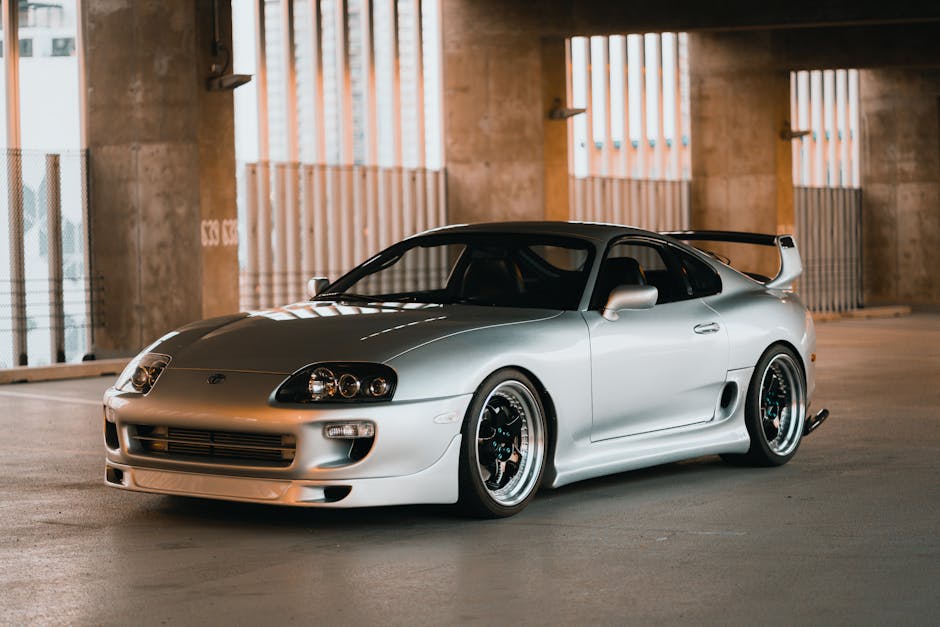Toyota Supra: 10 Ultimate Power Facts for 2025
The Evolution of an Icon: The Toyota Supra
The toyota supra is a legendary sports car and grand tourer manufactured by Toyota Motor Corporation, first introduced in 1978 and currently in its fifth generation. For those looking for quick information on the Toyota Supra:
| Toyota Supra Quick Facts | Details |
|---|---|
| Current Generation | Fifth generation (2019-present) |
| Base Price | $46,440 (2.0) to $69,085 (MkV Final Edition) |
| Engine Options | 2.0L 4-cyl (255hp) or 3.0L 6-cyl (382hp) |
| Transmission | 8-speed automatic or 6-speed manual |
| 0-60 mph Time | 3.9 seconds (3.0 with manual transmission) |
| Fuel Economy | 22/29 mpg (automatic), 19/26 mpg (manual) |
Born as a longer, wider variant of the Celica designed to accommodate a straight-six engine, the toyota supra has evolved from a comfortable grand tourer into one of the most iconic Japanese sports cars ever made. Its name comes from the Latin prefix meaning “above” or “to surpass,” perfectly capturing the vehicle’s mission to exceed expectations.
The Supra’s journey spans five distinct generations, with a 17-year production hiatus between 2002 and 2019. The current model, co-developed with BMW, offers a blend of German engineering and Japanese sports car philosophy, continuing the nameplate’s legacy of performance and style.
What makes the Supra special isn’t just its impressive performance figures, but its cultural impact. From dominating motorsports in the JTCC/Super GT championships to becoming a tuner’s dream in the 1990s and 2000s, the Supra has cemented its place in automotive history. The fourth-generation (A80) model with its legendary 2JZ engine became particularly famous for its incredible tuning potential and starring role in “The Fast and the Furious” film franchise.
Today’s GR Supra balances track-ready performance with everyday usability, offering buyers a complimentary 1-year NASA (National Auto Sport Association) membership that includes a High-Performance Driving Experience.

Toyota supra helpful reading:
History & Evolution of the Toyota Supra
The story of the toyota supra begins with American car buyers in mind. In the late 1970s, Toyota dealers across the United States were clamoring for something to compete with the popular Datsun 280Z. Toyota’s answer? Take their existing Celica, stretch it out, and drop in a straight-six engine. The Celica Supra was born.
There’s poetry in the name itself. “Supra” comes from Latin, meaning “above,” “to surpass,” or “go beyond” – perfectly capturing the spirit of a car that would continuously push boundaries throughout its existence. What started as a Celica variant would eventually blossom into Toyota’s crown jewel sports car.
Toyota Supra through Five Generations
First Generation (A40/A50; 1978-1981)
The original Celica Supra wasn’t exactly a tire-smoking monster. Debuting in 1978 with a 2.6-liter inline-six making a modest 110 horsepower, this first iteration was more highway cruiser than corner carver. With its longer wheelbase accommodating that six-cylinder heart, it offered comfortable seating, power windows, and luxury touches that were rare finds in Japanese sports cars of the day. The M-series engine might not have been powerful by today’s standards, but it established the Supra’s DNA – smooth, inline-six power.
Second Generation (A60; 1981-1986)
By 1981, the second-generation Supra (A60) rolled onto the scene with sharper styling and more personality. Still sharing Celica bones, Toyota now offered two distinct flavors: the comfort-focused “L-type” and the sportier “P-type.” Those iconic pop-up headlights made their first appearance, and tech-savvy buyers could marvel at the futuristic digital dashboard – cutting-edge stuff for the early ’80s. Power climbed to a more respectable 145-175 horsepower depending on where you bought it and when.
Third Generation (A70; 1986-1993)
In 1986, the Supra finally cut ties with the Celica, emerging as its own model with the A70 generation. This was where things got serious. Toyota introduced turbocharged variants with the 7M-GTE engine pumping out up to 232 horsepower. The A70 also brought sophisticated tech like Toyota’s Electronically Modulated Suspension (TEMS) and ABS brakes.
For the hardcore enthusiasts, Toyota created something special – the limited-edition Turbo-A. Only 500 were built, specifically to homologate the Supra for Group A racing. These rare beasts featured more power and improved aerodynamics, becoming instant collectors’ items.
Fourth Generation (A80; 1993-2002)
If there’s automotive royalty in the Japanese sports car world, it’s the fourth-generation Supra (A80). Unveiled in 1993, it was lighter, sleeker, and more aerodynamic than its predecessor. Under the hood lurked the now-legendary 2JZ-GTE – a twin-turbocharged inline-six producing 320 horsepower in export models that could rocket the Supra from 0-60 mph in just 4.6 seconds.
The 2JZ engine became the stuff of legend. Built with incredible tolerance and strength, it could handle massive power increases with relatively simple modifications. Some enthusiasts have pushed these engines beyond 1,000 horsepower while maintaining surprising reliability. The A80’s production ended in the U.S. in 1998 and globally in 2002, beginning a 17-year hibernation for the nameplate.
Fifth Generation (J29/DB; 2019-present)
After years of rumors and concept cars, the Supra finally returned in 2019 as the fifth-generation model (J29/DB). Developed in partnership with BMW and sharing architecture with the Z4, the new GR Supra (now under Toyota’s Gazoo Racing performance division) offers either a 2.0-liter four-cylinder or a 3.0-liter inline-six – both turbocharged and BMW-sourced.
Despite the German DNA underneath, the new Supra maintains the model’s traditional front-engine, rear-wheel-drive layout and distinctive double-bubble roof. When it launched in 2019, it marked a triumphant return for one of Japan’s most beloved sports cars.
Cultural Milestones of the Toyota Supra
Few cars have left a cultural footprint as deep as the toyota supra. The A80 fourth generation, in particular, achieved immortality when it starred in 2001’s “The Fast and the Furious,” driven by Brian O’Conner (Paul Walker). That bright orange Supra with its wild graphics introduced the car to millions of moviegoers who might never have noticed it otherwise.
On the racetrack, the Supra built a formidable reputation. It battled fiercely in Japan’s JTCC (Japanese Touring Car Championship) and later in the Super GT series. One of its proudest moments came in 1991 when the A70 Supra claimed overall victory at Australia’s grueling Bathurst 12 Hour endurance race, proving its performance credentials on the world stage.
The Supra’s dragon logo, seen on many special editions and racing versions, became nearly as recognizable as Toyota’s own emblem among enthusiasts. When the import tuner scene exploded in popularity during the 1990s and 2000s, the Supra – particularly the A80 with its sequential twin-turbo setup – stood at the center of it all. The 2JZ engine’s legendary durability allowed enthusiasts to create some of the most powerful street-legal cars of the era.
While Toyota sold only about 12,000 A80 Supras in North America during its production run, demand has skyrocketed in recent years. Well-preserved examples now command six-figure prices at auction, with particularly rare variants fetching astronomical sums – a testament to the model’s enduring appeal and the passionate community that surrounds it.
For more on the racing heritage that shaped cars like the Supra, check out our deep dive into Sports Car Racing History.
Toyota Supra Performance & Driving Experience
The current GR toyota supra delivers a driving experience that perfectly balances thrilling performance with surprising everyday usability. Pop the hood and you’ll find one of two BMW-sourced turbocharged engines: the muscular B58 3.0-liter inline-six pumping out 382 horsepower, or the spirited B48 2.0-liter inline-four with 255 horsepower for those who prefer a lighter touch.
With the six-cylinder under the hood, this Japanese icon rockets from 0-60 mph in just 3.9 seconds with the manual transmission (even quicker with the automatic). That’s genuine sports car territory! Weighing in at a well-balanced 3,343 pounds, the GR Supra feels nimble and responsive while maintaining enough substance to feel planted on the road.

Perhaps the most exciting development for true enthusiasts was Toyota’s decision to introduce a 6-speed intelligent Manual Transmission (iMT) option for the 3.0-liter model in 2023. After years of fan requests, Toyota delivered a properly engaging driving experience with this slick-shifting gearbox. The clever iMT system even optimizes engine revs during shifts for buttery-smooth operation – though purists can turn this feature off for a more raw experience.
The chassis and suspension setup is equally impressive. The Adaptive Variable Suspension (AVS) constantly adjusts damping force based on how you’re driving and what the road surface is doing beneath you. Meanwhile, the electronic rear differential can vary from completely open to fully locked in milliseconds, helping you put power down whether you’re launching from a stoplight or carving through corners.
As a thoughtful bonus, Toyota includes a complimentary 1-year NASA (National Auto Sport Association) membership with every new GR Supra purchase. This includes a High-Performance Driving Experience event where you can safely explore your car’s limits under professional guidance. Now that’s a perk worth celebrating!
Engine Options in the Toyota Supra
The heart of any sports car is its engine, and the fifth-generation toyota supra offers two compelling choices:
The flagship B58 3.0L inline-six (found in 3.0 and 3.0 Premium models) is a masterpiece of modern engineering. With 382 horsepower peaking at 6,500 rpm and a meaty 368 lb-ft of torque available from just 1,800 rpm all the way to 5,000 rpm, this engine provides effortless acceleration in virtually any situation. Its twin-scroll turbocharger virtually eliminates lag, making the power delivery feel almost naturally aspirated.
For those seeking a more affordable entry point, the B48 2.0L inline-four (in the base 2.0 model) is no slouch either. With 255 horsepower and 295 lb-ft of torque, it still delivers a 0-60 time of around 5 seconds – plenty quick for spirited driving. This engine comes exclusively with the 8-speed automatic transmission, which shifts with remarkable precision and speed.
Both engines feature sophisticated twin-scroll turbocharger technology that separates exhaust pulses for better response and reduced lag. The 3.0-liter’s broad torque plateau is particularly impressive, making the car feel responsive regardless of what gear you’re in.
Drivers can select from several driving modes that transform the car’s personality by adjusting throttle response, transmission behavior, steering weight, exhaust sound, and suspension settings. Manual transmission models even feature a special “Hairpin+” mode that allows for more controlled wheelspin when powering out of tight uphill corners – perfect for those mountain road trips!
Toyota Supra Driving Impressions
Behind the wheel, the toyota supra feels special from the moment you press the start button. The steering is direct and communicative, offering genuine feedback through corners without the artificial heaviness that plagues many modern sports cars. The short 97.2-inch wheelbase contributes to the Supra’s agile character, making it feel nimble and eager to change direction – a true driver’s car.
Braking performance is equally confidence-inspiring. The GR Supra stops from 70 mph in approximately 150 feet, rivaling dedicated sports cars with much higher price tags. The limited MkV Final Edition ups the ante with larger Brembo brakes featuring improved cooling for fade-free performance even during intense track sessions.
What truly sets the Supra apart from many of its competitors is its remarkable daily usability. Despite its performance credentials, the suspension soaks up road imperfections with surprising compliance. The Adaptive Variable Suspension deserves much of the credit here, firming up when you’re attacking corners but softening appropriately for highway cruising. It’s this dual-nature personality that makes the Supra such a compelling proposition as both a weekend toy and daily driver.
That said, potential buyers in colder climates should note one limitation: despite being rear-wheel drive, the GR Supra isn’t the ideal winter companion. Even with quality winter tires fitted, our testing revealed some challenges in snowy conditions – something to consider if you’re planning year-round use in areas with harsh winters.
Inside, the cabin wraps around you like a cockpit, with all controls angled toward the driver. Taller folks might find the headroom slightly tight due to the distinctive double-bubble roof design, but the 14-way power-adjustable seats in higher trim levels provide excellent support during spirited driving while remaining comfortable for longer journeys.
Real-World MPG & Efficiency for the Toyota Supra
One of the most pleasant surprises about the toyota supra is how efficiently it sips fuel despite its performance credentials. According to EPA estimates, the 3.0-liter models with automatic transmission deliver 22 mpg city, 29 mpg highway, and 25 mpg combined. Opt for the manual transmission, and those numbers adjust to 19 city, 26 highway, and 21 combined.
The 2.0-liter four-cylinder models are even more frugal, with EPA ratings of 25 mpg city, 32 mpg highway, and 28 mpg combined – impressive figures for a sports car with this level of performance.
What’s even more remarkable is that in real-world testing, the GR Supra often exceeds these estimates, particularly during highway cruising. During a 75-mph highway test, a similarly equipped Supra achieved an eye-opening 36 mpg – efficiency you’d expect from a family sedan, not a high-performance sports coupe!
This impressive efficiency stems from several factors: advanced turbocharging technology, relatively lightweight construction, slippery aerodynamics with a drag coefficient of just 0.29, and the sophisticated 8-speed automatic transmission that keeps engine speeds relaxed during steady cruising.
For the most up-to-date fuel economy information for specific model years and configurations, we recommend checking the EPA’s website before making your purchase decision.
Ownership & Buying Guide
Dreaming of putting a toyota supra in your garage? I don’t blame you! This iconic sports car delivers thrills at every turn, but before you take the plunge, let’s talk about what ownership really looks like.
The 2026 GR Supra lineup starts at $46,440 for the entry-level 2.0 model and climbs to $69,085 for the limited-production MkV Final Edition. In between, you’ll find the 3.0 model ($58,035) and 3.0 Premium ($58,550), each offering their own blend of performance goodies and luxury touches.
Toyota makes buying a Supra pretty straightforward with traditional financing, lease options, and occasional cash incentives. These deals change with the seasons and vary by region, so it’s worth checking Toyota’s website or swinging by your local dealer to see what’s currently on offer. And hey, if you’re a recent college grad or military member, you might qualify for additional rebates – potentially saving you several hundred dollars!
Looking at the pre-owned market? Used GR Supras currently average around $51,096 based on 267 listings. If you’re shopping used, cars with clean histories (about 170 available at the time of writing) typically cost more but offer greater peace of mind. Worth the premium, if you ask me.
When it comes to warranty protection, Toyota has you covered with their standard package:
- Basic warranty: 3 years/36,000 miles
- Powertrain warranty: 5 years/60,000 miles
- ToyotaCare: 2 years/25,000 miles of complimentary scheduled maintenance
While some competitors offer longer terms, that included ToyotaCare maintenance is a nice touch – covering your oil changes and tire rotations for the first two years means more money in your pocket for gas (or modifications!).
New Toyota Supra Trim Levels & Special Editions
The toyota supra family has something for everyone, from the more accessible four-cylinder model to limited editions that’ll turn heads wherever you go.
The 2.0 (Base Model) starts things off with a 2.0-liter turbocharged four-cylinder making a respectable 255 hp. For $46,440, you get 18-inch cast-aluminum wheels, Alcantara/leather-trimmed seats, and an 8.8-inch infotainment display with Apple CarPlay. It’s the most affordable ticket to the Supra club.
Step up to the 3.0 model at $58,035, and you’re rewarded with the heart-pounding 3.0-liter turbocharged inline-six producing 382 hp. You can choose between an 8-speed automatic or 6-speed manual transmission (yes, three pedals!), plus you get 19-inch forged wheels, Adaptive Variable Suspension, and an active rear sport differential for sharper handling.
The 3.0 Premium builds on that foundation for $58,550, adding heated leather seats, a thumping 12-speaker JBL audio system, wireless Apple CarPlay, and a head-up display that lets you keep your eyes on the road where they belong.
For those seeking exclusivity, the 45th Anniversary Edition ($65,275) celebrates the Supra’s heritage with unique Mikan Blast (orange) or Absolute Zero (white) paint, matte black 19-inch forged wheels, and special interior trim with anniversary badging. Production is limited, so you won’t see yourself coming and going.
The crown jewel is the MkV Final Edition, limited to just 1,300 units in North America. Priced at $69,085, it features revised differential mapping, larger Brembo brakes, stiffer bushings, and retuned adaptive dampers for even sharper handling. Visually, it stands out with matte-black 19-inch wheels, a carbon-fiber spoiler and mirror caps, and red interior accents. True track enthusiasts can opt for the GT4-Style Pack with a matte exterior finish and racing-inspired graphics.

Toyota has released other special editions throughout the fifth generation’s run, including the Launch Edition (2020), A91 Edition (2021), and A91-CF Edition (2022), each with unique styling elements and limited production numbers that make them future collector items.
How to Score the Best Toyota Supra Deal
Want to bring home a toyota supra without breaking the bank? Here’s my insider advice for getting the best possible deal:
Keep an eye on Toyota’s official website for national promotions – these typically refresh monthly and might include attractive APR offers, lease specials, or cash incentives. The “View Local GR Supra Offers” tool is particularly handy, showing you dealer-specific deals in your area that might be even better than the national offers.
Timing matters more than you might think. Dealers get especially motivated near month-end or quarter-end when they’re pushing to hit sales targets. The end of the model year (usually late summer or early fall) can also yield better deals as dealers clear out inventory to make room for incoming models.
Don’t forget to check if you qualify for Toyota’s special eligibility programs – both college graduates and military personnel can score a $500 rebate that stacks with other incentives. That’s a nice dinner out or a tank of premium fuel!
When shopping the pre-owned market, use CARFAX filters for “No Accident or Damage Reported,” “CARFAX 1-Owner,” and “Well Maintained” to find the cream of the crop. These cars might cost a bit more upfront, but they’ll typically save you headaches (and money) down the road.
If you’ve got your heart set on a limited edition like the MkV Final Edition, building a relationship with your local dealer before these models are released can improve your chances of securing one at MSRP rather than paying the dreaded “market adjustment” markup.
Here’s a little secret – if you can drive a stick, consider the manual transmission Supra. They sometimes have less demand than automatics, potentially giving you more negotiating leverage or better availability.
And don’t forget to factor in the complimentary 1-year NASA membership with a High-Performance Driving Experience that comes with every new GR Supra – that’s several hundred dollars of value that makes the overall deal even sweeter.
Pros & Cons of Owning a Toyota Supra
Every rose has its thorns, and the toyota supra is no exception. Let’s talk honestly about the highs and lows of Supra ownership:
On the bright side, the GR Supra delivers exceptional performance that rivals cars costing twice as much. The acceleration and handling will put a smile on your face every time you hit the starter button. Unlike many high-performance sports cars, the Supra offers surprising daily drivability with a ride comfortable enough for commuting. The impressive fuel economy from both engine options means you won’t be best friends with your local gas station attendant.
The Supra also enjoys strong resale value thanks to limited production numbers and its legendary status. The complimentary NASA membership lets you safely explore your car’s limits on a track with professional instruction – a truly valuable experience. And while it shares components with BMW, the Supra benefits from Toyota’s reputation for reliability and quality control.
That said, there are some drawbacks. The tight cabin might feel claustrophobic for taller drivers, and there’s not much storage space for your small items. The trunk offers just 10 cubic feet of cargo space – enough for a weekend getaway, but you’ll need to pack light. Only Apple CarPlay is available, leaving Android users without native smartphone integration.
Some owners report annoying wind buffeting with the windows down at highway speeds, and the low seating position and thick pillars create some blind spots (though the driver assistance features help mitigate this). Lastly, some purists lament the heavy BMW influence, though this partnership is what made the Supra’s return possible in the first place.
Despite these minor gripes, owner satisfaction remains extremely high – 91% of 2024 Toyota GR Supra owners give the car a perfect 5-star rating, with an overall average of 4.9 out of 5. As one happy owner put it: “It’s a Supra – what else needs to be said?”
Supra in Car Culture, Motorsports & Future Outlook
The toyota supra isn’t just a car—it’s a motorsport icon with deep racing roots that continue to grow today. When Toyota revived the Supra nameplate, they made sure it would honor its competition heritage, developing the GR Supra GT4 as a turnkey race car available to customer teams competing in GT4 series worldwide.
American racing fans have seen the Supra silhouette tearing around NASCAR Xfinity Series tracks since 2019, where it replaced the Camry as Toyota’s entry. While these NASCAR versions share little mechanically with their road-going counterparts, they keep the Supra name in the spotlight of American motorsport culture.
Back in Japan, where the Supra legend was born, the GR Supra competes in the prestigious Super GT series in the GT500 class. This continues a proud tradition that stretches back through multiple generations of Supras that dominated the JGTC (Japan Grand Touring Car Championship) in years past.
Racing isn’t just happening on physical tracks, either. The digital field has acceptd the toyota supra through various esports competitions and prominent features in popular racing games like Forza Horizon and Gran Turismo. These virtual appearances have introduced the Supra to a whole new generation of enthusiasts who might never have experienced the earlier models that built the nameplate’s reputation.

With the announcement of the MkV Final Edition, the rumor mill has kicked into high gear about what might come next. Is this truly the end of the current generation, or perhaps the Supra nameplate altogether? The automotive world’s dramatic shift toward electrification suggests any future Supra would likely incorporate electric power in some form—whether as a hybrid or a full EV.
Toyota’s developing bZ (beyond Zero) electric vehicle platform could potentially serve as the foundation for an electric Supra successor, though the company remains tight-lipped about official plans. Equally uncertain is the future of Toyota’s partnership with BMW for sports car development beyond the current generation.
What seems certain is that whatever shape a future Supra might take, it would need to maintain the model’s soul—the performance, driver engagement, and head-turning styling that have made the Supra such an enduring icon among enthusiasts worldwide.
Toyota Supra in Competitive Racing
From weekend track days to international championships, the toyota supra continues to prove itself as a genuine competitor. The GR Supra GT4 represents the most direct link between what you can buy at a dealership and what competes on racetracks globally.
This factory-developed race car maintains the road car’s basic structure but adds the necessary competition upgrades: a reinforced chassis, competition-grade brakes, specialized suspension components, and a tuned version of the B58 engine producing up to 430 horsepower (depending on series regulations). The GT4 has collected trophies in numerous championships, including the IMSA Michelin Pilot Challenge in North America, GT4 European Series, and Japan’s grueling Super Taikyu Series.
What’s particularly special about the Supra’s racing program is how it directly influences the cars customers can buy. The MkV Final Edition incorporates several track-inspired improvements that came directly from competition experience: larger Brembo brakes with improved cooling capacity, firmer suspension bushings, and revised differential mapping that improves cornering stability at the limit. For those wanting to look the part, the optional GT4-Style Pack adds visual elements inspired by the race car.
Toyota goes a step further by including a complimentary NASA (National Auto Sport Association) membership with every new GR Supra purchase. This thoughtful touch gives owners access to track days and potentially entry-level racing opportunities, encouraging them to safely explore their car’s capabilities away from public roads.
The Future of the Toyota Supra
As we watch the automotive landscape transform before our eyes, the future of beloved performance cars like the toyota supra hangs in an exciting but uncertain balance. With the MkV Final Edition coming for 2026, Supra fans everywhere are wondering what Toyota might have up its sleeve next.
Several intriguing possibilities exist for a potential sixth-generation Supra:
The most likely path seems to be a hybrid evolution that would maintain the inline-six architecture while adding electric assistance. This approach would preserve the Supra’s character and distinctive sound while improving both efficiency and performance through the instant torque that electric motors provide.
More would be full electrification—building a Supra on Toyota’s dedicated EV platform. While this would represent a significant departure from tradition, it could deliver breathtaking performance if Toyota’s engineers maintain their focus on the driving experience that makes a Supra special.
History might repeat itself with an extended hiatus, similar to the 17-year gap between the fourth and fifth generations. Toyota might choose to pause the Supra nameplate until technology or market conditions align perfectly with their vision for what a Supra should be.
Finally, the BMW partnership could continue into another generation, potentially with greater differentiation between the Supra and Z4 successors to address some enthusiasts’ concerns about the current models’ similarities.
Whatever Toyota decides, one thing seems certain: well-maintained examples of the current GR Supra—particularly limited editions—will likely increase in value over time. The announcement of the Final Edition has already sparked renewed interest in the used market, with pristine examples commanding premium prices.
At Car News 4 You, we’re keeping our fingers on the pulse of Automotive Tech Innovations that might shape the Supra’s future, and we’ll continue bringing you the latest developments as part of our commitment to covering the fascinating intersection of car culture and cutting-edge automotive technology.
Frequently Asked Questions about the Toyota Supra
What engine choices does the current Toyota Supra offer?
Curious about what’s under the hood of the toyota supra? You’ve got two impressive options to choose from:
The base 2.0 model comes with a BMW-sourced B48 2.0-liter turbocharged inline-four that kicks out a respectable 255 horsepower and 295 lb-ft of torque. This engine only comes paired with an 8-speed automatic transmission – perfect if you prefer letting the car handle the shifting while you focus on the road ahead.
If you’re craving more power (and who isn’t?), the 3.0 models feature the beefier B58 3.0-liter turbocharged inline-six producing a thrilling 382 horsepower and 368 lb-ft of torque. Here’s where things get interesting – you can choose between an 8-speed automatic or a satisfyingly engaging 6-speed manual transmission. The choice between rowing your own gears or letting the automatic do its thing comes down to personal preference, but there’s something special about connecting with a sports car through a proper manual gearbox.
Both engines benefit from twin-scroll turbocharger technology that virtually eliminates turbo lag, giving you responsive acceleration whenever you need it. The inline-six is particularly smooth – a characteristic that’s become increasingly rare in today’s automotive landscape – with peak torque available from a low 1,800 rpm all the way to 5,000 rpm. This broad power band means you’re never caught waiting for the engine to catch up with your right foot.
How does the Toyota Supra compare to rivals like the Porsche 718 Cayman and Nissan Z?
The toyota supra occupies a fascinating sweet spot in the sports car market. It’s neither the most expensive nor the most affordable option, yet it delivers performance that punches well above its weight class.
When compared to the Porsche 718 Cayman, the Supra represents a compelling value proposition. With a starting price around $46,440 – significantly less than the Cayman’s $63,400 entry point – the Supra 3.0 delivers acceleration figures that match or beat many Cayman variants. Only the high-performance GTS and GT4 models can clearly outpace it, and those will set you back well over $80,000.
The Cayman does have advantages, though. Its mid-engine layout provides a uniquely balanced handling character that the front-engine Supra can’t quite match, despite its excellent chassis tuning. The Porsche also boasts superior interior materials and that intangible Porsche prestige factor. Storage is surprisingly similar between the two, though the Cayman’s front and rear trunk arrangement offers more flexibility than the Supra’s conventional trunk.
Looking at the Nissan Z comparison, the price gap narrows considerably. The Z starts around $41,000, making it slightly more affordable than even the base Supra 2.0. However, the Supra 3.0 delivers noticeably sharper handling and quicker acceleration than its more traditionally styled Japanese rival. Both cars carry impressive heritage, with the Z’s lineage actually predating the Supra by nearly a decade.
The Z does offer a bit more interior space – a blessing for taller drivers who might find the Supra’s cabin snug. On the technology front, the Supra generally offers more sophisticated driver assistance features and a more refined infotainment experience.
At the end of the day, the Supra hits a sweet spot: offering near-Porsche performance with pricing that’s much closer to the Nissan Z. It’s the Goldilocks option for many sports car enthusiasts who want maximum performance per dollar without sacrificing daily usability.
Is the Toyota Supra likely to be discontinued after the MkV Final Edition?
The announcement of the MkV Final Edition for 2026 has definitely raised eyebrows among toyota supra fans. When a carmaker uses the words “Final Edition,” it’s natural to wonder what comes next – if anything.
While Toyota hasn’t made any official announcements about discontinuing the Supra, there are several signs pointing to a significant change on the horizon. The limited production run of just 1,300 units for North America has the feeling of a farewell tour rather than just another special edition. Add to that the fact that Toyota’s partnership with BMW (which underpins the current Supra) may be reaching its natural conclusion, and the writing seems to be on the wall for the fifth-generation model.
But don’t despair just yet! The Supra has taken extended vacations before. There was a 17-year gap between the fourth generation’s departure in 2002 and the current model’s arrival in 2019. Rather than a permanent goodbye, we might be looking at another hibernation period before a reimagined Supra emerges – possibly with some form of electrification given the industry’s overall direction.
Toyota’s continued investment in their Gazoo Racing performance division suggests they’re not abandoning the performance car market entirely. The Supra name carries too much cultural weight and passionate following to discard completely. Whether it returns as a hybrid, full electric, or in some other form we haven’t even considered yet remains to be seen.
What seems most likely is that Toyota is closing this chapter of the Supra story – the BMW partnership era – and taking time to write the next one. The automotive landscape is changing rapidly, and the next Supra will need to evolve with it while maintaining the soul that has made it an icon for nearly five decades.
We’ll be keeping our ears to the ground for any official announcements about the Supra’s future and sharing them as soon as we hear anything concrete. In the meantime, if you’ve been thinking about adding a fifth-generation Supra to your garage, the clock may be ticking.
Conclusion
The toyota supra has earned its place in automotive history as one of the most beloved Japanese sports cars ever created. Its journey from a stretched Celica variant to the high-performance GR model we know today spans nearly five decades and showcases Toyota’s commitment to delivering driving excitement that resonates with enthusiasts around the world.
What makes today’s GR Supra special is how it manages to honor tradition while embracing innovation. The BMW partnership that brought the fifth generation to life might have raised eyebrows among some die-hard fans, but it’s hard to argue with the end result – a thoroughly modern sports car that delivers exhilarating performance without the six-figure price tag of many comparable vehicles.
The Supra’s double-bubble roof, distinctive proportions, and driver-focused cockpit continue a design language that makes it instantly recognizable, while its turbocharged powertrains deliver the straight-line thrust and sonorous exhaust note that Supra owners have always cherished.
As we look toward the horizon with the MkV Final Edition on the way, there’s a sense of both excitement and uncertainty about what comes next. Will we see another extended hiatus like the 17-year gap between the fourth and fifth generations? Or perhaps an electrified evolution that maintains the Supra spirit while embracing automotive’s electric future? Only time will tell.
For those lucky enough to own a GR Supra, you’re not just purchasing a thrilling driving machine – you’re potentially making a sound investment. Limited production numbers, especially of special editions, combined with the model’s iconic status typically support strong resale values. And let’s not forget the included NASA membership that encourages you to experience your Supra’s capabilities on the track, where it truly shines.
The toyota supra represents everything we love about cars at Car News 4 You – the perfect blend of heritage, performance, and driving passion. It’s a rolling testament to the engineering excellence and emotional connection that keeps car enthusiasm such a rewarding pursuit. Even as the automotive landscape evolves rapidly around us, vehicles like the Supra remind us why we fell in love with cars in the first place.
We’ll continue tracking developments in the Supra story and bringing you updates on its future as part of our ongoing coverage of the luxury sports car world. After all, few vehicles better exemplify the intersection of car culture and automotive innovation that we’re passionate about.
For more insights into performance and luxury vehicles that deliver similar thrills, be sure to explore our other coverage at Luxury Car Trends.







